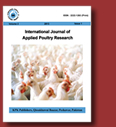|
|
|
|
|
|
|
|
The abnormal skin structure of newly born Wistar rat maternally-treated
with aspartame: histological and immunohistochemical study
|
|
Abd El-Fattah BM El-Beltagy1 and Heba AI El-Ghawet2 |
|
1Zoology
Department, Faculty of Science, Damanhour University; 2Department
of Zoology, Faculty of Science, Mansoura University, Egypt
|
| |
| Abstract |
|
Aspartame is an artificial sweetener and flavour enhancer in
low-calorie, with sweetness about 200 times higher than sugar. The
present study aims to declare the effect of aspartame on the
histological
and immunohistochemical structures of the skin in Wistar albino rat
neonates. Twelve pregnant female Wistar-albino rats were separated into
two groups, a control and an experimental group (n = 6). The first group
was orally administered a daily dose of saline solution (0.5ml) free
from the 4th day of pregnancy till birth. The second group
was orally administered 40mg aspartame/kg body weight for the same
period. Samples from the dorsal abdominal
skin of one day-old
neonatal rats were fixed in 10% buffered neutral formalin and prepared
routinely for histopathological and immunohistochemical investigations.
Other samples were taken immediately, frozen and prepared
for flow cytometric investigation of annexin V. Compared with the
control group, the skin of aspartame treated neonatal rats showed a
significant decrease (P<0.05) in the epidermal and dermal thickness as
well as hair follicle depth. The epidermis appeared foliated with
obvious hypertrophied cells; other dispersed cells had pyknotic nuclei
and vacuolated cytoplasm. The dermis showed less condensed connective
tissue, degenerated sebaceous glands and scarcely irregular hair
follicles. The immunohistochemical investigations of aspartame neonatal
rats showed intense positive reactions for Caspse-3, P53
and vascular endothelial growth factor (VEGF) but a negative to
weak reaction for Caspase-7 and CK17
antibodies. Furthermore, the flow cytometric analysis of the
annexin V revealed a significant increase in the apoptotic area
corresponding to upper right (UR) and lower right (LR) area. In
conclusion, the consumption of aspartame by mother rats during gestation
leads to remarkable histological lesions and increased risk of apoptosis
in the skin of their neonatal pups.
|
|
Keywords:
Aspartame; skin; neonatal; histopathology; apoptosis
|
| |
| To cite this article:
Abd El-Fattah BM El-Beltagy and AI El-Ghawet H,
2016.
The abnormal skin structure of newly born Wistar rat maternally-treated
with aspartame: histological and immunohistochemical study.
Res.
Opin. Anim. Vet. Sci., 6(5): 151-157. |
|
|

